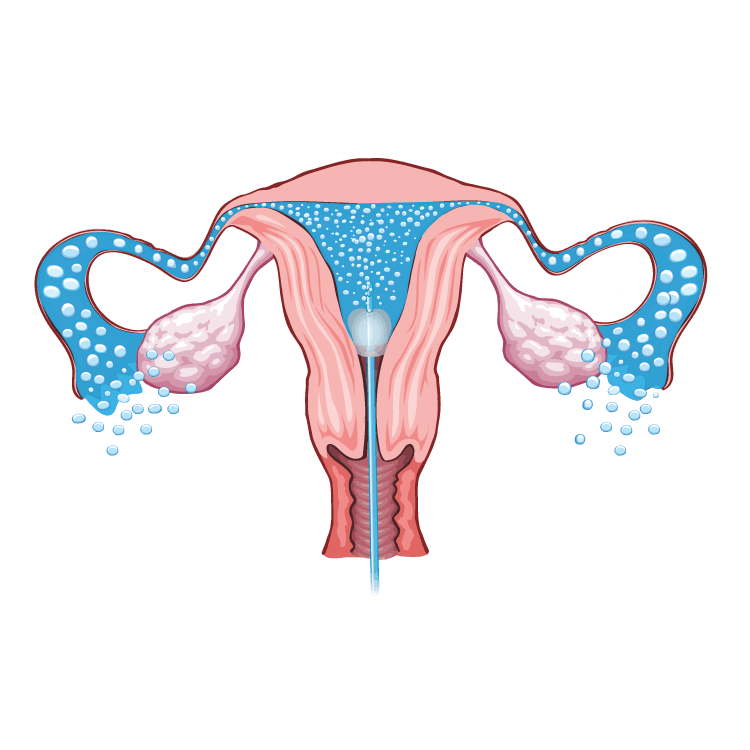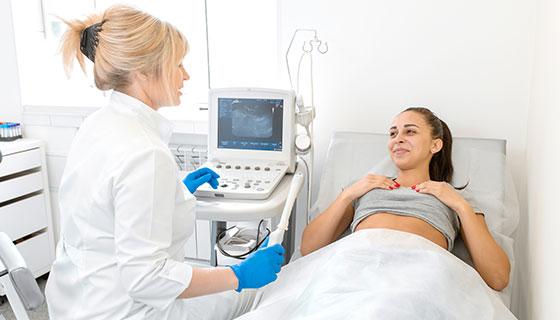Kanaa Fertility Centre is one of the top-rated clinics in Chennai providing Sonohysterography. Our team of experts helps patients interested in knowing what is SSG and it benefits before the actual procedure. Book Now!
Sonohysterography is a procedure to look at the inside of the uterus. It’s a safe, painless test that uses sound waves and a computer to create images. It does not use radiation. Sonohysterography does not use ionizing radiation, has no known harmful effects, and provides a clear picture of soft tissues that don’t show up well on x-rays.
Procedure: A thin, flexible tube (catheter) is inserted into the cervix. Saline is sent through the catheter into the uterus. At the same time, the transducer sends high-frequency sound waves through the gel and into the body. The echoes from these sound waves create a real-time image of the inside of the uterus. This shows the structure of the uterus. The saline fluid helps the ultrasound form an image with sharper detail. This information helps to diagnose a number of different health conditions
The flow of fluid through the tubes into the pelvis when saline is injected can be visualised on the ultrasound and hence is used to determine tubal patency

The SIS procedure is conducted in a fertility clinic under the guidance of an expert:

Although routine ultrasound of the uterus is a helpful screening test, it may not delineate the lining of the uterus or minor abnormalities. A Sonohysterogram (SIS test) or saline infusion sonogram employs saline infusion to fill up the uterine cavity. This yields a clearer, more precise view of the uterus so that embryologists and gynecologists can pick up on fine uterine abnormalities that a standard uterus ultrasound might not. Uterus sonography with saline renders the best visualization for fertility testing.
Following a saline infusion sonogram, the pictures are examined closely by your fertility expert. The uterus ultrasound pictures formed throughout the SIS test can determine:
Clear imaging of SIS findings assists in planning fertility treatment, directing interventions, or determining the causes of infertility.
A Sonohysterogram, also called a saline infusion sonogram, is a safe procedure that uses saline infusion and uterus ultrasound to create detailed images of the uterine cavity. It helps detect fibroids, polyps, scarring, or abnormal uterine shapes.
Sonohysterography is prescribed to find the underlying cause of many problems, including abnormal uterine bleeding, infertility, and repeated miscarriage.
In a patient with regular menstrual cycles, sonohysterography should, in most cases, be performed by day 10 of the menstrual cycle. In cases of intermittent or prolonged abnormal uterine bleeding, treatment with a short course of progestin may be considered to enable timing of the procedure.
Other tests may be used to diagnose problems of the uterus:
Sonohysterography has some benefits over other tests used to get information about the uterus. Other tests include:
· Hysterosalpingography. This is a type of X-ray that uses radiation and a fluid that is a radioactive dye.
· Hysteroscopy. This is a surgical procedure that needs to be done with anaesthesia. But this procedure also helps to treat certain problems when it is diagnosed.
· MRI. This is an imaging test done with large magnets and a computer. An MRI may not give a clear picture of the inside of the uterus.
Sonohysterography is limited in the assessment of the patency, or openness, of the fallopian tubes because of their size and structure. In cases your doctor suspects an abnormality of the fallopian tubes, they may recommend Hysterosalpingography or diagnostic hystero lap for further evaluation.
Most women are able to go home right away and are back to their normal activities that day. Some of the following symptoms may occur after the test:
· Cramping
· Spotting or light bleeding
· Watery discharge
Most patients experience mild cramping or discomfort during the saline infusion sonogram, but it is generally well-tolerated and considered a minimally invasive test.
The SIS test can identify:
It is typically done after menstruation but before ovulation (days 6–12 of the cycle), when the endometrial lining is thin for optimal visualization.
Yes, the flow of saline infusion through the fallopian tubes can be observed during the procedure, helping evaluate tubal health for fertility treatments.
The procedure is very safe. Mild cramping or spotting may occur, but SIS has no radiation and no known harmful effects.